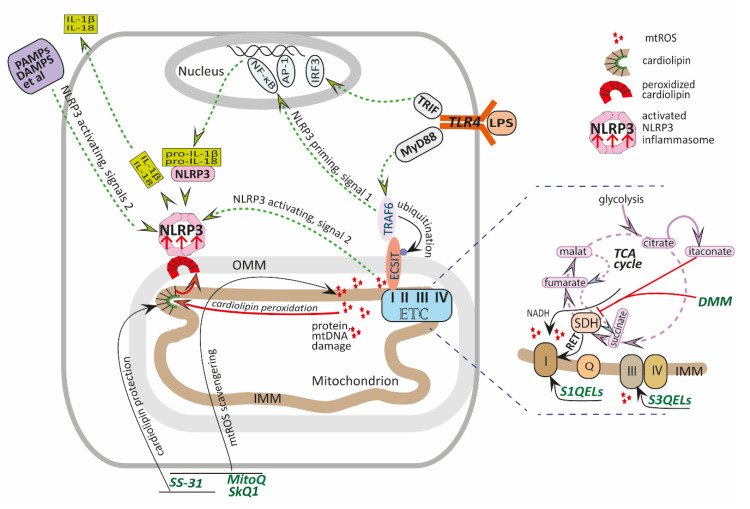Figure 1.
Diagram illustrating the protective mechanisms of mito-AOX against the LPS-induced cell inflammatory response. Activation of TLR4 by LPS triggers MyD88- or TRIF-dependent signaling pathways, resulting in the translocation of nuclear transcription factors NF-κB, AP-1, and IRF3 into the nucleus. This leads to the initiation of transcription of a wide range of pro- and anti-inflammatory mediators. LPS-induced priming of the NLRP3 inflammasome mediated by the adapter protein TRAF6 and NF-κB results in transcription of NLRP3 and inactive pro-IL-1β and pro-IL-18 proteins. In addition, TRAF6 is translocated to the mitochondria and ubiquitinates ECSIT, a protein implicated in complex I assembly and stability, resulting in its enrichment at the mitochondrial periphery and facilitation of mtROS production. Complexes I and III of the ETC are the main sites of mtROS production. In conditions of low forward electron transport, complex I can generate mtROS via NADH oxidation as well as via reverse electron transport (RET) from SDH to complex I (see the text). Inhibition of SDH by the TCA cycle derivative itaconate, as well as malonate or cell-permeable dimethyl malonate (DMM), attenuates RET and consequently diminishes mtROS production. mtROS serve as one of the numerous NLRP3 activating signals that cause the assembly and activation of the NLRP3 inflammasome complex and maturation and secretion of IL-1β and IL-18. In addition, mtROS damage proteins and mtDNA and induce lipid peroxidation. Oxidized cardiolipin is translocated from the IMM to the OMM, where it serves as a docking station for NLRP3. Mito-AOX, such as MitoQ, SkQ1, or SS-31, accumulate within the IMM to scavenge mtROS. SS-31, besides its ROS-scavenging properties, binds selectively to cardiolipin, increasing lipid packing of the membrane and tightening membrane curvatures, thus protecting the ETC and mitochondrial function. S1QELs and S3QELs, small molecules from different chemical families, specifically suppress mtROS production at ETC sites IQ and IIIQo, respectively. Abbreviations: DAMP—damage-associated molecular pattern; ECSIT—evolutionarily conserved signaling intermediate in Toll pathways; ETC—electron transport chain; LPS—lipopolysaccharide; IMM—inner mitochondrial membrane; NLRP3—NLR family pyrin domain containing receptor 3 inflammasome; OMM—outer mitochondrial membrane; PAMP—pathogen-associated molecular pattern; mtROS—mitochondrial reactive oxygen species; SDH—succinate dehydrogenase.

